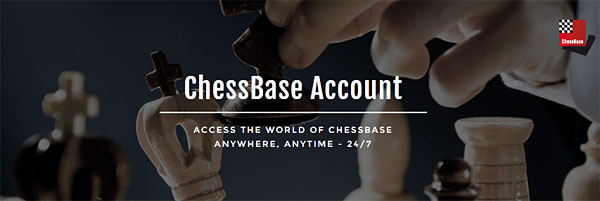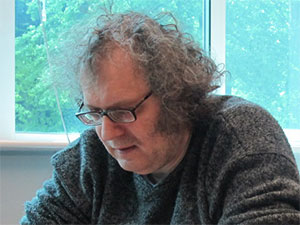Jon Speelman's Agony Column #23

This week's pair of games are by Michael Bacon, who is in his sixties, retired and lives in a lake house in Lavonia, a small city in Georgia, "with my wife Patricia, three cats (Zorro, Pepper, and Snowy), and Copper the dog, whom we sometimes call 'Copperton'."
Michael learned chess in his twenties and is an all round games player, making his living for many years through playing backgammon, and also playing poker, bridge and latterly Go on the Internet. In his early twenties he worked the demonstration boards at the Church's Fried Chicken tournament in San Antonio 1972 and met the sponsor Bill Church, the players and indeed Bobby Fischer.
Michael was champion of the city of Atlanta from 1974-6 and proudly says he has beaten a number of grandmasters ... in backgammon. He wrote a chess blog at one time: "Armchair Warrior" (retired) and says that he avidly follows Kevin Spraggett's blog! The two games he sent me are a fine encapsulation of the Agony and Ecstasy of chess in a microcosm, with a victory against a strong opponent in one round of the 1986 US Open Championship and then a heavy defeat against an opponent who was appreciably less formidable (on paper) in the next.

[Event "US Open"] [Site "Boden"] [Date "1986.??.??"] [Round "?"] [White "Pinto, Mark"] [Black "Bacon, Michael"] [Result "0-1"] [ECO "B16"] [Annotator "Jonathan"] [PlyCount "102"] [EventDate "2012.??.??"] [SourceDate "2015.07.13"] {In this hard fought battle, Michael got a very decent position after a somewhat provocative opening, tried an interesting if somewhat controversial piece sacrifice that went slightly wrong, but then rallied and won very nicely after his opponent allowed a beautiful king march.} 1. e4 c6 2. d4 d5 3. Nc3 dxe4 4. Nxe4 Nf6 5. Nxf6+ gxf6 {In this line, Black allows some damage to his pawn structure but gets central control and the g file. It's not very highly regarded by theory but does initiate a fight right out of the opening.} 6. c3 Qd5 {6...Bf5 is more common but this is also often played and perhaps mildly irritating for White.} 7. Ne2 Bg4 8. f3 Bf5 9. Ng3 Bg6 10. Qb3 {[#]Forcing the exchange of queens which gives White some edge with nice control of the queenside and chances of harrassing the g6 bishop.} Qxb3 11. axb3 e6 12. Be3 Nd7 13. b4 f5 {Although this incarcerates the bishop at least temporarily it gives Black quite active play.} 14. Bc4 Nb6 15. Bb3 Nd5 16. Bd2 Be7 17. O-O h5 {Seizing some space.} 18. Ne2 (18. Nh1 $1 h4 19. Nf2 Rg8 20. Nd3 {might give an edge.}) 18... h4 19. Nf4 Nxf4 20. Bxf4 h3 21. g3 a6 22. Be5 Rg8 23. Kf2 Bg5 24. f4 Be7 25. Bc7 Kd7 26. Bb6 Bh5 {Michael has played very actively and looks about equal.} 27. Rfe1 Bd6 28. Rg1 Rg6 29. Bc4 Rag8 30. Rae1 {[#]This allows quite an enticing sacrifice.} (30. Ke3 {would have prevented it though Black must be absolutely fine anyway.}) 30... Bxf4 $5 31. gxf4 Rg2+ 32. Rxg2 Rxg2+ 33. Ke3 Rxh2 {This position is really hard to judge. As Black I'd be extremely nervous that White would find a way to get the b6 bishop back into the game. But White is disorganised and the h pawn a real problem.} 34. Bd3 Ke7 (34... Rxb2 35. Rh1 h2 {is probably dynamically equal. Of course White would get the advantage if he could somehow manoeuvre the bishop to block the second rank on f2 or d2. But it's miles away and he must be careful for instance if} 36. Bc5 Bg4 37. Bf8 Rg2 38. Bh6 $2 Rg3+ 39. Kd2 Rh3 {wins since Black threatens both Rxh6 and Bf3.}) 35. Bc5+ Kf6 36. Bf8 Rg2 37. Bf1 Rg3+ 38. Kf2 Rf3+ 39. Kg1 Bg4 {This is much more precarious for Black, but even so he seems okay.} 40. Bh6 ({ I wondered about} 40. d5 cxd5 41. Bc5 {to activate the bishop, but} Rxf4 42. Bd4+ Kg6 43. Kh2 Re4 $1 {still seems to be perfectly okay} 44. Ra1 e5 45. Bf2 Rf4 46. Bg3 Re4) 40... Kg6 41. Bg5 {[#]} f6 $6 (41... Kh5 {would have prevented Bh4 with dynamic equality.}) 42. Rxe6 $6 (42. Bh4 $1 {gave White better chances.} Rxf4 (42... Kf7 43. Bc4 $1) 43. Kh2 Kh5 44. Bg3 Re4 45. Bxh3 Rxe1 46. Bxe1 f4 {when White must be better but Black's pawns are pretty strong and it's far from simple. One interesting line goes} (46... Bxh3 47. Kxh3 f4 48. Bh4) 47. Bxg4+ Kxg4 48. Kg2 e5 49. c4 $1) 42... h2+ 43. Kxh2 Rxf1 44. Rxf6+ Kg7 45. Rd6 (45. d5 cxd5 46. Rb6 {was a bit better and safe.}) 45... Rf2+ {[#]} 46. Kg1 $2 {After putting the king on the back rank, White must be very careful.} (46. Kg3 Rxb2 47. Bf6+ Kf7 48. Be5 Rd2 49. Rf6+ $5 ({Of course} 49. Rd7+ Kg6 {is absolutely fine for White, indeed} 50. d5 Rxd5 51. Rxb7 { is uncomfortable for Black.}) 49... Ke7 50. Kh4 Rd3 51. c4 {White would have the more active king and while it should be a draw would crucially be in no danger whatsoever.} Rh3+ 52. Kg5 Be2 53. Rxf5 (53. c5 Rg3+ 54. Kh6 $11)) 46... Rxb2 47. Rd7+ {encouraging a very dangerous enemy king march} (47. d5 {looks sensible}) 47... Kg6 {[#]} 48. Rxb7 $2 {Of course} (48. Rd6+ {would just be a draw if White wanted.}) 48... Bf3 49. Rb6 $2 (49. Re7 Be4 50. Re6+ Kh5 51. Rh6+ Kg4 52. Rh2 $1 {would still have been fine since Black must exchange rooks now or later} Rb1+ 53. Kf2 {threatening Rh4 mate} Rb2+) 49... Kh5 50. Rxa6 $4 { Allowing the net to be closed. Houdini tells me (of course I can see it myself but it's helpful to be reassured) that} (50. Kf1 Kg4 51. Ke1 {may still be playable since if} Re2+ ({but} 51... Ra2 {say leaves White most uncomfortable.} ) 52. Kd1 {the discovered checks are all harmless.}) 50... Kg4 51. Ra1 Kg3 { [#]and White resigned. Michael was at pains to tell me how gracious his opponent was after losing this very hard battle.} 0-1

[Event "US Open"] [Site "?"] [Date "1986.??.??"] [Round "?"] [White "Bacon, M."] [Black "Caldwell, D."] [Result "0-1"] [ECO "C24"] [Annotator "Jonathan"] [PlyCount "46"] [EventDate "1986.??.??"] [SourceDate "2015.07.13"] 1. e4 e5 2. Bc4 Nf6 3. d3 c6 4. Nf3 d5 5. exd5 $6 {This makes life very easy for Black as the knight can come out to c6 to defend e5.} (5. Bb3 {is normal since if} dxe4 ({Instead} 5... Bd6 {is the main line}) 6. Ng5 {White has an edge.} (6. Nxe5 $4 Qa5+)) 5... cxd5 6. Bb3 Nc6 7. Bg5 Be7 8. Nc3 d4 (8... Be6 { keeping the centre intact is also at least equal.}) 9. Bxf6 {[#]} gxf6 { Doubling the pawns is much more challenging than the obvious recapture with the bishop. Black gets another pawn which can advance to f5 without weakening the b3-g8 diagonal and opens the g file.} (9... Bxf6 10. Ne4 Be7 11. O-O O-O 12. Re1) 10. Nd5 Be6 11. Nxe7 Qxe7 12. Qe2 O-O-O 13. Nd2 Rhg8 14. f3 {This creates a juicy target for the black knight on e3.} (14. g3 {was better.}) 14... Nb4 {[#]} 15. Bxe6+ $2 {Improving Black's pawn structure and no less important facilitating the knight's progress towards e3..} (15. a3 Nd5 16. Bxd5 Bxd5 {is uncomfortable but far from fatal.}) 15... fxe6 16. Kf2 Kb8 17. Nc4 { The knight will defend e3 here but isn't entirely stable - Black might even tee up to play ...Rxc4 one day - and its opposite number on d5 is much more threatening since it can also jump to f4.} Nd5 18. g3 Rg5 19. a4 Rdg8 20. a5 h5 21. Qe4 Qg7 {[#]} 22. a6 $2 {Losing outright but} (22. Rhg1 h4 23. g4 Rc8 { is most unpleasant. Black has a very stable centre, the f4 square for the knight whenever he wants and taking care to avoid any White counterplay which might destabilise the position can aim to improve. Obviously the following "variation" is pretty much random moves, especially by White. But at the end of it after evacuating the king from the queenside, doubling rooks on the c file and organising the kingside, Black is poised to play ...Rxc4 with defastating effect:} 24. Qe1 Qh6 25. Kg2 Rg7 26. Ra3 Qg5 27. Rb3 Rc5 28. Kh1 Rgc7 29. a6 b6 30. Qe4 Rd7 31. Re1 Kc8 32. Ra1 Kd8 33. Re1 Ke8 34. Kg1 Kf8 35. Kh1 Kg7 36. Kg1 Rdc7 37. Qe2 Nf4 38. Qf1 Qg6 {[#]}) 22... Rxg3 $1 23. hxg3 Qxg3+ {A sad reverse after the fine effort the previous round.} 0-1
Did you enjoy the column and instructive analysis by GM Jonathan Speelman? Do you wish you could have a world-renowned grandmaster analyzing your play? You can! Just send in two of your games: one success story (Ecstasy) and one loss (Agony). Tell why you chose them, where or when they were played, and if they are selected, not only will you get free detailed commentary of your games by one of chess’s great authors and instructors, and former world no. 4 player, but you also win a free one-month Premium subscription to ChessBase Account.

A one-month Premium subscription to ChessBase Account, means that for one month you get:
- Premium access to the Playchess server with ratings, simuls, lectures, and live commentary of top games.
- Access to all Web apps with no restrictions, such as the Cloud database (MyGames.chessbase.com), and more!
- Full access to the Video archive, which not only includes all the past lectures by Daniel King, Simon Williams and others, but also a large number of full ChessBase products you would normally need to buy in the ChessBase Shop, but that you can view for free as a Premium subscriber.


























